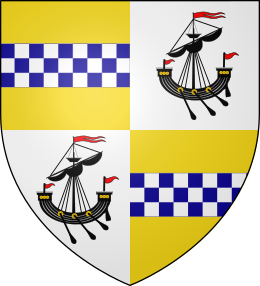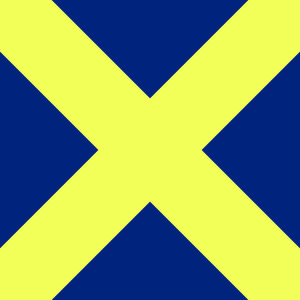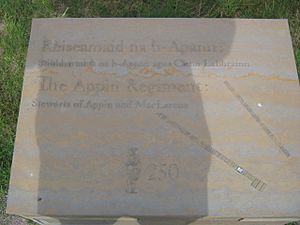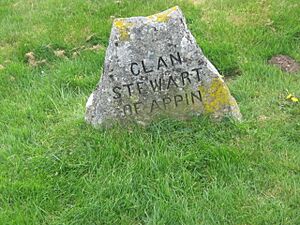Clan Stewart of Appin facts for kids
Quick facts for kids Clan Stewart of Appin |
|||
|---|---|---|---|
| Stiùbhairt | |||
| Motto | Quihidder Wil Ȝie (Whither will ye? i.e., what/which will you choose?) | ||
| War cry | Creag an Sgairbh ("The Cormorant's Rock") (Castle Stalker sits atop this) | ||
| Profile | |||
| District | Appin Duror, West Coast Scotland, above Oban, below Ballaculish | ||
| Plant badge | Darag (Oak) | ||
| Animal | Unicorn | ||
| Pipe music | Bratach Bhàn nan Stiùbhartach (The white banner of the Stewarts) | ||
| Chief | |||
 |
|||
| Andrew Francis Stewart of Lorn, Appin and Ardsheal, 17th of Appin & 12th of Ardsheal | |||
| (MacIain Stiùbhairt na h-Apainn) | |||
| Seat | Castle Stalker | ||
| Historic seat | Castle Stalker | ||
|
|||
|
|||
|
|||
|
|||
The Clan Stewart of Appin is a special group of the larger Clan Stewart from the West Scottish Highlands. They have been their own distinct clan since the 1400s. Their leaders are related to Sir James Stewart of Perston, who was the grandson of Alexander Stewart, the fourth High Steward of Scotland. The Stewarts of Appin are cousins to the Royal Stewart family, who once ruled Scotland.
Contents
History of the Appin Stewarts
How the Clan Began
The Appin Stewarts are a branch of the Clan Stewart from the West Highlands. Their family line comes from Sir James Stewart of Perston. He was the great-grandson of Alexander, the fourth High Steward of Scotland. Sir James's grandson, John Stewart of Innermeath, married Isabel MacDougall. She was the daughter of John Gallda MacDougall, who was the Lord of Lorne. This marriage made John Stewart the first Stewart Lord of Lorne. The title of Lord of Lorne was passed down for two more generations.
The area of Appin is on the west coast of Scotland. It is located between Benderloch to the south and Ballachulish to the north. Today, the main towns there are Port Appin and Portnacroish. These places are very beautiful, surrounded by forests and water. To the west are islands like Lismore. This island is home to the MacLea family. There are many interesting places to see in Appin. These include Ardsheal's Cave, Castle Stalker, and Eilean Munde.
The 1400s: A Time of Change
Stories say that in 1445, Sir John Stewart, the third Stewart Lord of Lorne, met a woman from the MacLaren family. He fell in love with her. Even though he was already married, they had a son named Dugald a year later. Dugald later became the founder of the famous Clan Stewart of Appin.
After his first wife passed away, Sir John decided to marry Dugald's mother. In 1463, Sir John planned his wedding. He sent for Dugald and his mother to come to Dunstaffnage Castle. But, a secret plan was made to kill the Lord of Lorne. It is believed that this plot was started by the Lord of the Isles. He was fighting for power with the King of Scots. He wanted to get rid of Sir John, who was a strong supporter of the King.
As the wedding group walked to a small chapel near the castle, they were attacked. The attackers were led by Alan MacCoul. Sir John was badly hurt. He was rushed into the chapel. With his last breath, Sir John married Dugald's mother. This made Dugald his legal son and the rightful Lord of Lorne. After Sir John died, Dugald gathered his supporters and the MacLarens. They tried to take back Dunstaffnage Castle, but they could not.
Colin Campbell, Lord Argyll, who might have been part of the plot, helped MacCoul. MacCoul's men and the MacFarlanes fought against Dugald's men and the MacLarens. This battle was called Leac a dotha. Both sides lost many fighters.
For the next few years, Dugald worked to make his power stronger. He had lost the title of Lord of Lorne because of his uncle Walter Stewart and Lord Argyll. But he still controlled Appin and Lismore. He made Castle Stalker stronger. He also made sure the Campbells knew he was unhappy. His clan often raided Campbell lands.
Finally, in 1468, Colin Campbell and Walter Stewart planned a big attack against Dugald. Alan MacCoul was involved again. They fought at a battle known as the Battle of Stalc. Dugald's clan lost many men. But they almost completely destroyed the fighting strength of the MacFarlanes. Dugald also personally killed Alan MacCoul, the man who had killed his father. This battle made Dugald's claim to Appin very strong. King James III officially gave him the land on April 14, 1470. In 1497 or 1498, Dugald Stewart of Appin was killed fighting against the Clan MacDonald of Keppoch at the Battle of Black Mount.
The 1600s: Supporting the King
The Clan Stewart of Appin supported the King's side during the Civil War in the 1600s. They fought alongside James Graham, the 1st Marquess of Montrose, in battles like Battle of Inverlochy (1645). After King James VII was removed from power in 1688, the Stewarts of Appin continued to support the old royal family, the House of Stuart.
The 1700s: Jacobite Risings

The Appin clan naturally supported the Jacobite risings. These were attempts to bring the old Stuart kings back to the throne. They sent men to fight in the Jacobite rising of 1715. In 1724, it was thought that the clan had about 400 fighting men. Dugald Stewart, the 9th Chief of Appin, was given the title Lord Appin in 1743 by the Jacobite side.
Appin also sent men to fight in the Jacobite rising of 1745. At the Battle of Culloden in 1746, the Appin Regiment had about 300 fighters. They lost 92 killed and 65 wounded. Charles Stewart of Ardsheal led the regiment. This group included men from about 19 other clans, especially Clan MacLaren. After the battle, Ardsheal escaped Scotland. He went to Europe to be with his family and lived there for the rest of his life.
Ardsheal's Cave: A Hiding Place
On July 23, 1745, Prince Charles Edward Stuart (also known as Bonnie Prince Charlie) landed in Scotland. He was trying to claim the Scottish and English thrones. This started the second Jacobite uprising. But on April 16, 1746, the Jacobite cause was defeated at the Battle of Culloden.
Charles Stewart of Ardsheal was one of the Prince's leaders. After the battle, he hid from the English soldiers, called "Red Coats." They were searching everywhere for those who had supported the Prince. The place where he hid became known as Ardsheal's Cave. It is located on a steep hillside above Kentallen Bay in Loch Linnhe.
The Stewarts of Ardsheal were a very important family within the Appin clan. They were completely loyal to the Jacobite cause. Stewart of Ardsheal led the Appin regiment at Culloden. They fought bravely and caused many problems for the Hanoverian army. However, the Jacobite army was tired, hungry, and outnumbered. They were defeated.
After their victory, the English army, led by the Duke of Cumberland, was very harsh. Many Jacobites were captured and punished. The clan system was also changed. Clans were disarmed, and wearing kilts and tartan was banned.
In this difficult time, Ardsheal returned home. He knew he would be in great danger if caught. So, he immediately went into hiding. He wanted to be near his wife and new baby son. With his wife's help, he hid in the cave above his house. His wife would bring him food. Sometimes, he would sneak out at night.
Eventually, the Red Coats came to Ardsheal House. They surrounded it and held his wife and child. She was very brave and did not tell them where her husband was. She said she had not seen him since he left with the Jacobite army. The Red Coats searched the area thoroughly. It is said that they walked very close to his hiding spot twice.
The secret to Ardsheal's success was the cave itself. It is hidden behind a tall waterfall. This waterfall completely hides the entrance, especially when there is a lot of water. Unless you know where it is, you could be standing very close and never find it. The cave goes back about 15 to 20 feet. It is easy to stand up in the front, but it gets smaller towards the back. The cave is a bit damp, but there is a drier spot at the back. It is a good hiding place and protects from the weather.
The only way to reach the cave is by climbing up a steep stream. It is quite a difficult climb from Ardsheal House. If someone knew where he was, it would be very hard to escape. The sound of the waterfall covers any approaching noises. The only way out is the same way in. This means pursuers would be on him very quickly. However, it was a perfect hiding spot. Charles Stewart of Ardsheal was known to be a strong man and a skilled swordsman.
The danger of capture continued for Charles Stewart of Ardsheal even after the Red Coats left. He realized that he would likely never be forgiven. So, Ardsheal eventually fled to France. His lands were taken by the Crown. Later, in the 1700s, his son Duncan Stewart of Ardsheal managed to get the lands back. The Stewarts of Ardsheal later became the Chiefs of Appin.
The Appin Mystery
Appin was the location of a famous mystery in 1752, known as the Appin Murder. A government official named Colin Roy Campbell of Glenure was shot by an unknown person. This happened while he was riding near Loch Leven at Ballachulish. He was known as 'the Red Fox'. He was in charge of lands that had been taken from the Stewarts.
Even though it was called a 'murder' by the court, such events were not uncommon at the time. The main suspect, Alan Breck Stewart, escaped. Then, James of the Glens, who was the half-brother of the clan chief, was accused. He was tried by a jury made up of Campbells in their stronghold of Inveraray. The judge was also a Campbell leader. James Stewart was found guilty and faced severe punishment near Loch Leven.
Most people at the time, and historians today, believe that James Stewart had nothing to do with the shooting. The story became famous because of Robert Louis Stevenson. He used the event in his famous novel Kidnapped. Many people have tried to figure out who the real shooter was, but without success. The current Chief of the clan says that his family knows the identity, but it has not been revealed. The "mystery" continues to this day.
Clan Leaders and Important Families
The "daoine uaisle" (Gaelic for "noble people") were important members of the clan. They were also known as "Tacksmen" or "Cadets." These were the gentry of the clan. They were usually related to the Chief by birth. These men controlled certain areas, or "tacks," within the clan's lands. They collected rents, which were sometimes paid to the Chief.
The main "Cadets" of Appin are the families of Ardsheal, Achnacone, Fasnacloich, Invernahyle, and Strathgarry. These important branches came from the sons of Alan Stewart, the 3rd Chief of Appin. Today, Andrew Francis Stewart of Lorn, Appin and Ardsheal is the current Chief of Appin. He is descended from Charles Stewart, 7th of Ardsheal.
Clan Members and Supporters
The supporters or "septs" (a modern term) of Appin come from families who lived in the Lorne area before the Stewarts took control. These include:
- The MacColls, who are said to be descended from Black Solomon.
- The MacLeays or Livingstones, who were on Lismore island as early as 1130.
- The MacGillemichaels, or their English form "Carmichael," who were in Appin before the 1200s.
- The Combichs, whose name came from a nickname in north Appin.
- The MacRobbs, who are actually Stewarts, descended from Robert, son of Dugald, the 1st Chief of Appin.
- The MacInnes, who moved to the area in the early 1400s.
Other supporters included the MacLaurins, Carmichaels, MacCombichs, MacColls, MacGillemichaels, McIlmichaels, MacInness, MacLeays, MacMichaels, and MacRobbs.
See also




